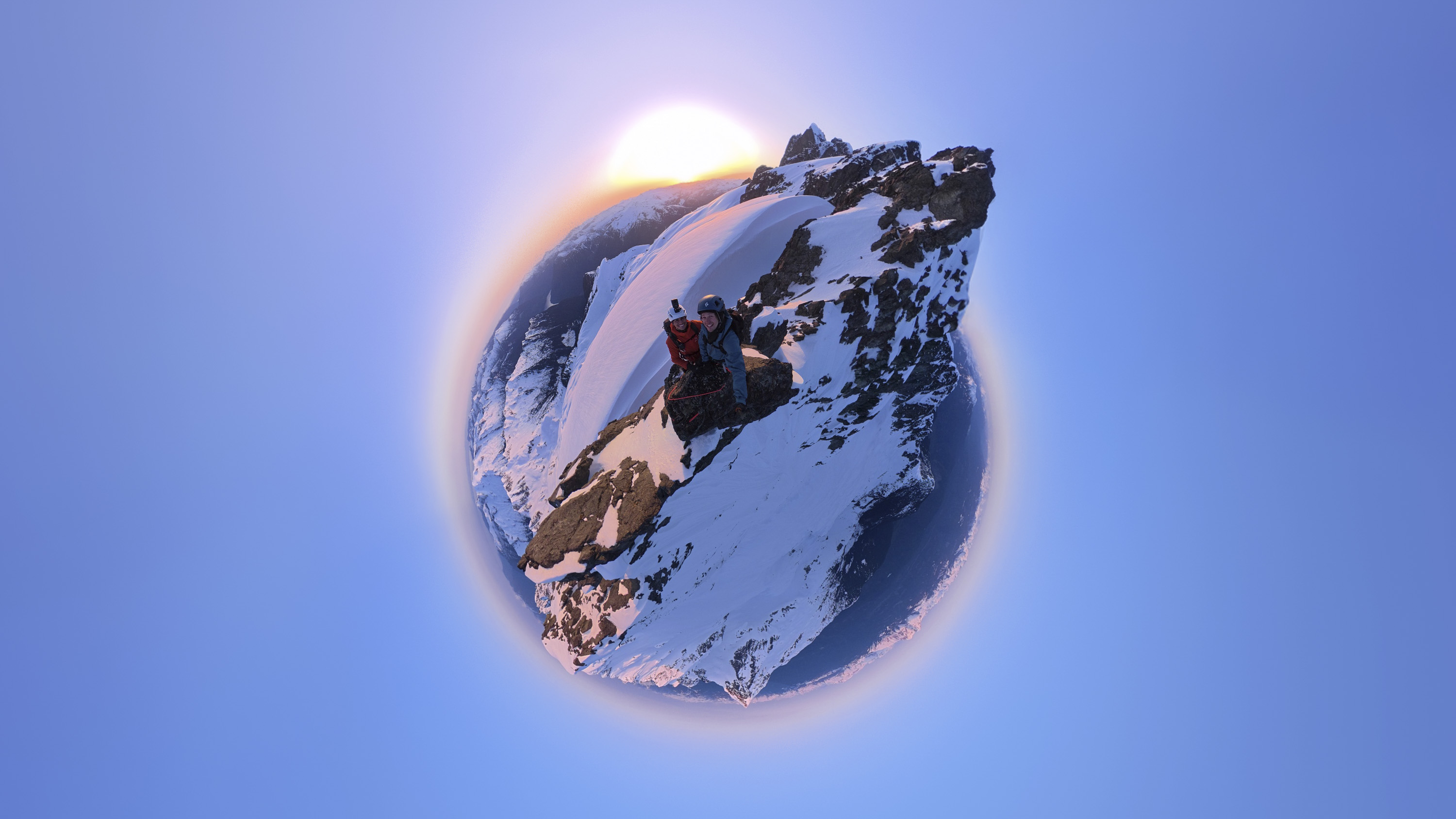After years owning the 360 camera space with some of the best 360 cameras, most recently the X5, Insta360 finally has some proper competition with the arrival of the DJI Osmo 360. They could soon be joined by the GoPro Max 2 too (if GoPro does indeed bring its long-awaited 360 camera to market).
DJI has a slightly different take on the format to Insta360, delivering what it says are several industry firsts, most notably twin 1-inch sensors. The immediate question, therefore, is which model is best? Can the Osmo 360 dethrone our current favorite, the X5?
You can learn more about DJI’s first 360 camera in our in-depth Osmo 360 review. We also have a hands-on versus feature on the way, for which we’re pitting the Osmo 360 against the Insta360 X5 in several scenarios to see which model comes out on top.
For now, let’s look at how the Osmo 360 and X5 compare based on the specs and features in seven key areas.
1. Sensors
- DJI Osmo 360: twin 1/1.1-inch square sensors with 2.4μm pixel size
- Insta360 X5: twin 1/1.28-inch sensors with 1.2μm pixel size
The headline feature of the DJI Osmo 360 is its twin sensors, specifically made for 360 capture. They’re square format, meaning less wasted pixels than on a traditional rectangular sensor like the one the X5 uses, given that 360 cameras only use the central portion of the sensor.
The sensors are effectively 1-inch in size, which means they’re the largest of their kind, and each pixel on the Osmo 360’s sensors is twice the size of those in the X5. Still, before the Osmo 360, the X5’s sensors were the largest, being bigger than the X4’s, so it’s hardly a slam dunk for DJI.
The advantage of larger pixels is, in theory, cleaner image quality, especially in low light, and a wider dynamic range, which is helpful in bright sunny conditions. Both cameras can shoot HDR video though, so expect plenty of detail in highlights and shadows with either camera.

2. Image quality
- DJI Osmo 360: 8K up to 50fps, 10-bit, 120MP stills
- Insta360 X5: 8K up to 30fps, 8-bit, 72MP stills
Both cameras shoot 8K video at their best; however the Osmo 360 offers frame rates up to 50fps, while the X5 tops out at 30fps. Stop the resolution down to 5.7K and frame rates even out, while at 4K both cameras can shoot 4x slow-motion video.
In addition to the benefits of its larger sensors we can expect richer color from the Osmo 360, because it can record 10-bit color depth, whereas the X5 is limited to 8-bit color depth. It also offers DJI’s D-Log flat color profile – a popular profile for serious filmmakers wanting the most amount of tonal detail, who don’t mind putting in time in the editing suite.
For 360 photography, the Osmo 360 shoots stills up to 120MP, while the X5 can record up to 72MP. Clearly, DJI’s stills pack more detail.
The specs favor DJI, then, but we’re currently conducting extensive tests with both cameras to see which comes out on top in real-world use.
3. Battery
- DJI Osmo 360: 1,910mAh battery
- Insta360 X5: 2,400mAh battery (an ‘Ultra’ 2,800mAh battery is also available)
At 1,910mAh, the Osmo 360’s battery has a lower capacity than the X5’s. However, DJI says its 360 camera is the first of its kind able to shoot 8K 30fps video continuously for up to 100 minutes.
Insta360 delivered an X5 firmware update, however, and one of the upgrades is improved battery life – it’s Endurance Mode is now available for 8K recording, and increases battery life to “just under two hours” of continuous recording.
There are often plenty of caveats to actual battery performance, and often the reality is less than what the makers claim, especially for action cameras.
That said, Insta360 also launched a new ‘Ultra’ battery for the X5 alongside that firmware update, which costs $49.99 / £44.99 (Australia pricing TBC). With its 2,800mAh capacity, battery life is improved by another 17%.
Each brand claims better battery life than the other – our upcoming real-world tests will reveal which is best.
4. Storage
- DJI Osmo 360: micro SD plus 105GB internal
- Insta360 X5: micro SD
Both cameras record to micro SD card, and are compatible with large-capacity cards for hours of 8K recording. However, the Osmo 360 also features 105GB of built-in storage, and two convenient ways to record media is a win for DJI.

5. Accessories
- DJI Osmo 360: DJI Mic 2 / Mic Mini wireless mic, numerous mounts
- Insta360 X5: Mic Air compatible, plentiful mounts and selfie stick options
Both Insta360 and DJI have had their skin in the action camera game for years, and each already has a wide range of accessories and mounts that can be used with their 360 cameras in various scenarios, whether that’s for biking, in-car action, or for selfies.
Until recently, DJI had the upper hand for audio recording, with its class-leading wireless mics. The Osmo 360 is directly compatible with the Mic 2 and Mic Mini. Yes, you can mix and match brands for wireless audio, but direct compatibility is all the more convenient.
However, Insta360 recently launched its own wireless mic, the Mic Air. While not quite the mic that DJI’s Mic 2 is, Insta360’s mic, like DJI’s, can be paired wirelessly and through Bluetooth within its respective eco system.
Insta360 is yet to launch a mic with the features of DJI’s Mic 2, though, so DJI still has the edge in this respect.
6. Price and availability
- DJI Osmo 360: from £409.99 / AU$759; not yet available in the US
- Insta360 X5: from $549.99 / £519.99 / AU$929.99
So, the Omso 360 seemingly has the advantage on all of the above – on specs alone at least. However, at launch there’s good news and bad news regarding the Osmo 360. The bad news is that it isn’t directly available at launch in the US. The good news is that, where you can buy it, it costs less than the X5, starting at £409.99 in the UK and AU$759 in Australia. That price is for the Standard Combo, while the Adventure Combo costs £539.99 / AU$989.
That price is super-impressive when you consider the twin 1-inch sensors (and built-in storage) on board. As for the US, I asked a DJI Spokesperson about Osmo 360 pricing and availability and they said: “The Osmo 360 will launch globally on Thursday, July 31, at 8AM ET, but it will not be available for sale immediately in the U.S. market through official DJI channels. We currently do not have an estimated timeline for when it will be available, but we will keep you posted when we do.”
It’s a similar story with DJI’s most recent drone, the Mavic 4 Pro, which hasn’t launched in the US. The picture for DJI in the US looks bleak.

7. Lenses and design
- DJI Osmo 360: 184g, 2-inch screen, fixed lenses, lens protectors available
- Insta360 X5: 200g, 2.5-inch screen, replaceable lenses
DJI’s Osmo 360 design is squarer than the X5’s, with the latter being taller and squeezing in a larger 2.5-inch touchscreen. At 184g, the Osmo 360 is about 10% lighter than the X5, but no one is really going to notice the difference in weight, even if it is mightly impressive how light DJI has made the Osmo 360 considering the features on board.
Both cameras come supplied with a rubber lens guard to keep the lenses safe when not in use, plus clear lens protectors for the times that the lenses are at risk of damage during use, such as when shooting extreme sports.
Those clear lens protectors can compromise image quality, though, introducing flare and softness. For best quality, you’re better shooting without them, even if that means the bulbous lenses are at risk.
The X5 has a feature unique to 360 cameras – replaceable lenses. You can buy spare lenses and, should you damage the original ones, swap them out for new ones. The DJI Osmo 360, like every other 360 camera, doesn’t offer this.
DJI Osmo 360 vs Insta360 X5: key specs
| Header Cell – Column 0 | DJI Osmo 360 | Insta360 X5 |
|---|---|---|
Sensor | 1/1.1-inch | 1/1.28-inch |
Video | 8.K up to 50fps | 8K up to 30fps |
Photos | 120MP 360 photo | 72MP 360 photo |
Size | 61 x 83 x 47mm | 46 x 124.5 x 38.2mm |
Weight | 184g | 200g |
Battery | 1,910mAh (100 mins 8K) | 2,400mAh (around 2 hours 8K) |
Storage | Micro SD, 105GB built-in | Micro SD |
Price | £409.99 / AU$759 / US N/A | $549.99 / £519.99 / AU$929.99 |
DJI Osmo 360 vs Insta360 X5: Early verdict
The specs favor the DJI Osmo 360 over the Insta360 X5 in multiple areas; its sensors are larger, it can shoot 10-bit video and higher resolution stills, plus it’s part of DJI’s eco system which includes the best wireless mics available.
There are aspects of the Insta360 X5’s design and performance that win out of the Osmo 360, not least of which are its replaceable lenses and stellar battery life.
On specs alone, the Osmo 360 has the overall edge, plus it costs less in regions where it is available. But what matters most is the actual user experience and, honestly, 360 cameras that can’t be measured by a bunch of numbers, rather what they do in real scenarios.
We’re currently conducting an in-depth comparison tests between the two models, and the early results are much closer than we expected. If you’re looking to buy a 360 camera, I highly recommend waiting for those results, coming soon.












